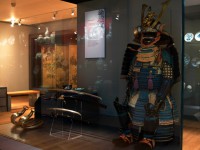Room 37 | Japan 1600-1850 gallery
Discover the arts of the Edo period (1600-1868) from porcelain to lacquer to painting.

The ‘Floating World’ (ukiyo in Japanese) was the name given to the fashionable world of licensed brothels, tea houses, and kabuki theatres that thrived in the entertainment districts of the cities during the Edo period (1600-1868).
The Floating World became a great source of inspiration for new kinds of art – popular literature, theatre, fashion, and ukiyo-e, or ‘pictures of the floating world’. These were woodblock prints and paintings depicting the famous courtesans, actors, and entertainers of the time.
In the Floating World, money and taste were more important than class. Samurai from the ruling class were discouraged from visiting the entertainment districts, but many enjoyed escaping from the formalities of daily life. Merchants, officially the lowest in society and banned from showy displays of wealth, were free to spend their leisure time and their fortunes there as they wished.
 The character Kogorō Hyōe at Umezu, between Ōiso and Odawara (EA1983.50)
The character Kogorō Hyōe at Umezu, between Ōiso and Odawara (EA1983.50)
 The character Okoma at Ōmori, between Shinagawa and Kawasaki (EA1983.48)
The character Okoma at Ōmori, between Shinagawa and Kawasaki (EA1983.48)
 The character Kanpei at Inohana, between Sakanoshita Tsuchiyama Kanpei (EA1983.49)
The character Kanpei at Inohana, between Sakanoshita Tsuchiyama Kanpei (EA1983.49)
 The character Benkei at Hashimoto, between Arai and Shirasuga (EA1983.51)
The character Benkei at Hashimoto, between Arai and Shirasuga (EA1983.51)
 The character Matsuōmaru at Matsuno'o, between Tsuchiyama and Minakuchi (EA1983.100)
The character Matsuōmaru at Matsuno'o, between Tsuchiyama and Minakuchi (EA1983.100)
Notice
Objects may have since been removed or replaced from a gallery. Click into an individual object record to confirm whether or not an object is currently on display. Our object location data is usually updated on a monthly basis, so contact the Jameel Study Centre if you are planning to visit the museum to see a particular Eastern Art object.
© 2013 University of Oxford - Ashmolean Museum
